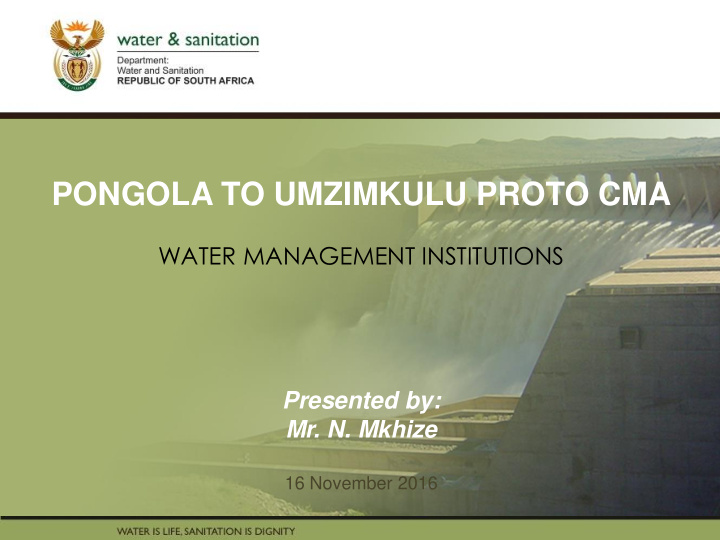



PONGOLA TO UMZIMKULU PROTO CMA PRESENTATION TITLE Presented by: WATER MANAGEMENT INSTITUTIONS Name Surname Directorate Date Presented by: Mr. N. Mkhize 16 November 2016
Presentation Outline • Legislative Mandate • WRM Framework • What is a CMA? • Mandate of the CMA • Reasons for the establishment of the CMAs • Water user associations • Catchment management forums • Establishment of the CMAs • WMA and CMAs
Legislative Mandate The Department of Water and Sanitation (DWS) is the custodian of National Water Resources , and is responsible for policy and regulation of the sector. Has a mandate to establish Water Management Institutions (WMI) for the development and management of water resources. In the absence of established CMA’s, DWS undertakes these functions.
WRM Framework FIRST TIER Minister (Overall responsible) DWS SECOND TIER CMA THIRD TIER WUA
What is a CMA? Statutory body established in terms of Chapter 7 of the Listed as National Water Act, schedule 3a 1998 (Act 36 of entity under the 1998) (NWA) PFMA-service delivery Public CMAs are entity established in terms of S78(1) of the NWA
Mandate of the CMA To investigate and advise on the protection, use, To co-ordinate the development, activities of water users conservation, and water management management and control institutions within its of the water resources water management area Purpose? Delegate water resource To develop catchment management to the management strategy for catchment level its water management area To promote community participation in the To promote co-ordination protection, use, between implementation development, of its CMS with implementation of water conservation, management and control services development of the water resources in plans by WSAs its water management area
REASONS FOR ESTABLISHING CMAs 2. 3. 1. To achieve To achieve To achieve Equitable Sustainable Efficient access use of water use of water to water Delegate WRM to regional or catchment level and to involve local communities within the framework of the National Water Resources Strategy (NWRS)
“Back to basics”: focus on purpose (as per NW Act) Basic human needs Water resources must be: Equitable access protected Redressing the past used Efficient, sustainable use To support developed Social & economic (achieve) development conserved protecting aquatic ecosystems managed Prevent pollution & controlled degradation valued Disasters, dam safety, international, growth 8
Water User Associations
WUAs Can be created on an initiative of an interested • party. Can also be created on the Minister's prerogative, • when he/she sees the need for such creation, e.g: • Local control of a government water scheme • Support of emerging farmers • Promote co-ordinated development of a resource A proposal for the creation of a WUA is prepared • and submitted to the Regional Offices for compliancy assessment A WUA is created after extensive and all-inclusive • Public Participation has taken place.
Catchment Mgmt Forums Catchment Forums are a formal non- statutory mechanism to facilitate participation of stakeholders with diverse interests Their strength is based on the stakeholders they represent rather than statutory powers Support functions once the CMA has been established: To promote integrated planning and cooperation between various stakeholders and role-players To support the operations of the CMA by performing activities and implementing projects
Establishment Of CMAs The National Water Resource Strategy (NWRS) 2004 • 19 Catchment Management Agencies (CMA) per Water Management Areas (WMA). eight CMAs were established, two were functional: the Inkomati and Breede- Overberg. • 6 CMAs were gazetted however, no Governing Boards were appointed. The process of establishing CMAs was put on hold in 2007 • Appropriate number of institutions was investigated through the “Institutional Reform and Realignment” (IRR) Project.
WMAs AND CMAs • The IRR made the following recommendations: • 9 WMAs to be overseen by 9 corresponding CMAs. This is ito the decentralisation of WRM which is a core component of the NWRS-2. • The WMAs were reduced to enable integrated planning and for socio-economic reasons. • The foreseen advantages of the amalgamation of WMAs include: Improved management of integrated systems which were previously split across WMAs. Support to a consolidated approach to international and counterparts in international basins. The enabling of more technically-capacitated areas to be linked to less- resourced capacitated areas. An improved balance in institutional revenue streams and economies of scale.
3 WMAs IN KZN (NWRS1) N Amsterdam S # MPUMALANGA Piet Retief SWAZILAND S # S # S # Pongola Paulpietersburg Louwsburg # S Utrecht Hlobane # S Newcastle Vryheid S # # S # S Nongoma S # USUTU TO MHLATHUZE WMA FREESTATE Dundee S # # S Glencoe Ulundi THUKELA WMA # S Mtubatuba # S St Lucia S # Ladysmith Melmoth # S # S Bergville Colenso Empangeni S # Winterton # S KWAZULU NATAL # S Weenen S # Richards Bay S # Eshowe S # # S Estcourt S # # S Mtunzini # S Mandini Greytown Mooirivier # S # S Darnall S # # S Zinkwazi Beach LESOTHO Wartburg S # Blythedale Beach Howick # S Salt Rock # S # S Empendle Pietermaritzburg # S S # # S Tongaat Himeville MVOTI TO UMZIMKULU WMA S # Richmond S # Durban Creighton S # S # Umbogintwini Ixopo S # INDIAN OCEAN # S Scottburgh Cedarville # S S # Kokstad S # # S # S Port Shepstone # S Ramsgate EASTERN CAPE 50 0 50 100 Kilometers
NEW WMAs
Thank You!!! 16
Recommend
More recommend